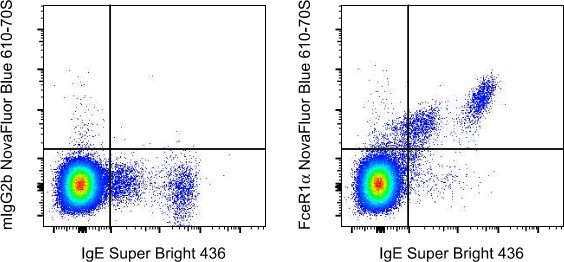Search Thermo Fisher Scientific
Invitrogen
FceR1 alpha Monoclonal Antibody (AER-37 (CRA1)), NovaFluor™ Blue 610-70S, eBioscience™
FIGURE: 1 / 2
FceR1 alpha Antibody (H033T03B06-A) in Flow


Product Details
H033T03B06-A
Species Reactivity
Host/Isotype
Class
Type
Clone
Conjugate
Excitation/Emission Max
Form
Concentration
Purification
Storage buffer
Contains
Storage conditions
RRID
Product Specific Information
Description: The AER-37 monoclonal antibody reacts with the Fc epsilon RI alpha subunit, an IgE-binding subunit lacking signal-transducing ability. Fc epsilon RI apha is expressed on mast and basophil cells and is upregulated by the presence of IgE. Fc epsilon RI alpha forms a tetrameric complex with one beta and two gamma subunits. The beta and gamma subunits possess immunoreceptor tyrosine-based activation motifs (ITAM). The Fc epsilon RI complex plays an important role in triggering IgE-mediated allergic reactions.
Each product contains 1 vial of NovaFluor conjugate and 1 vial of CellBlox Plus Blocking Buffer .
Applications Reported: This AER-37 (CRA1) antibody has been reported for use in flow cytometric analysis.
Applications Tested: This AER-37 (CRA1) antibody has been pre-titrated and tested by flow cytometric analysis of peripheral blood cells. This can be used at 5 µL (0.4 µg) per test. A test is defined as the amount (µg) of antibody that will stain a cell sample in a final volume of 100 µL. Cell number should be determined empirically but can range from 10^5 to 10^8 cells/test.
NovaFluor dyes are not compatible with DNA intercalating viability dyes. Do not use viability dyes such as propidium iodide, 7-actinomycin D (7-AAD) and DAPI. Invitrogen LIVE/DEAD Fixable Dead Cell stains are recommended for use with NovaFluor dyes.
This NovaFluor conjugate has been updated to ship with CellBlox Plus Blocking Buffer (Cat. No. (C001T06F01)). This buffer contains formulation improvements over CellBlox. CellBlox Plus Blocking Buffer is required for optimal staining with NovaFluor conjugates and should be used in all experiments where NovaFluor conjugates are used. Whenever possible, we recommend adding CellBlox Plus Blocking Buffer to antibody cocktails/master mixes prior to combining with cells. Add 5 µL per sample (regardless of the number of NovaFluors in your panel) to use the antibody cocktail as intended. For single-color controls, use 5 µL of CellBlox Blocking Buffer per 100 µL of cell sample containing 10^3 to 10^8 cells.
NovaFluor conjugates are based on Phiton™ technology utilizing novel nucleic acid dye structures that allow for engineered fluorescent signatures with consideration for spillover and spread impacts. Learn more
Excitation: 509 nm; Emission: 614 nm; Laser: 488 nm (Blue) Laser
Target Information
FceR1 (Fc epsilonR1 alpha) is a subunit of the high affinity receptor of IgE. Fc epsilonR1 alpha is a tetrameric complex consisting of one alpha, one ß and two additional subunits. The latter two are required for signal transduction activity. The Fc epsilonR1 complex plays an important role in triggering allergic responses, and the immunoglobulin epsilon receptor (IgE receptor) is the initiator of the allergic response. When two or more high-affinity IgE receptors are brought together by allergen-bound IgE molecules, mediators such as histamine, which are responsible for allergy symptoms, are released. The IgE receptor couples allergen and mast cells to initiate the inflammatory responses that are characteristic of disorders such as hay fever and asthma. The release of histamine and proteases leads to the synthesis of prostaglandins and leukotrienes-potent effectors of the hypersensitivity response.
For Research Use Only. Not for use in diagnostic procedures. Not for resale without express authorization.
How to use the Panel Builder
Watch the video to learn how to use the Invitrogen Flow Cytometry Panel Builder to build your next flow cytometry panel in 5 easy steps.
References (0)
Bioinformatics
Protein Aliases: fc epsilon r1; Fc epsilon receptor Ia; Fc epsilon RI alpha-chain; Fc fragment of IgE, high affinity I, receptor for; alpha polypeptide; Fc IgE receptor, alpha polypeptide; Fc-epsilon RI-alpha; FcERI; high affinity immunoglobulin epsilon receptor alpha-subunit; High affinity immunoglobulin epsilon receptor subunit alpha; IgE Fc receptor subunit alpha; immunoglobulin E receptor, high-affinity, of mast cells, alpha polypeptide; RP11-550P17.3
Gene Aliases: FCE1A; FCER1A; FcERI
UniProt ID: (Human) P12319
Entrez Gene ID: (Human) 2205

Performance Guarantee
If an Invitrogen™ antibody doesn't perform as described on our website or datasheet,we'll replace the product at no cost to you, or provide you with a credit for a future purchase.*
Learn more
We're here to help
Get expert recommendations for common problems or connect directly with an on staff expert for technical assistance related to applications, equipment and general product use.
Contact tech support

